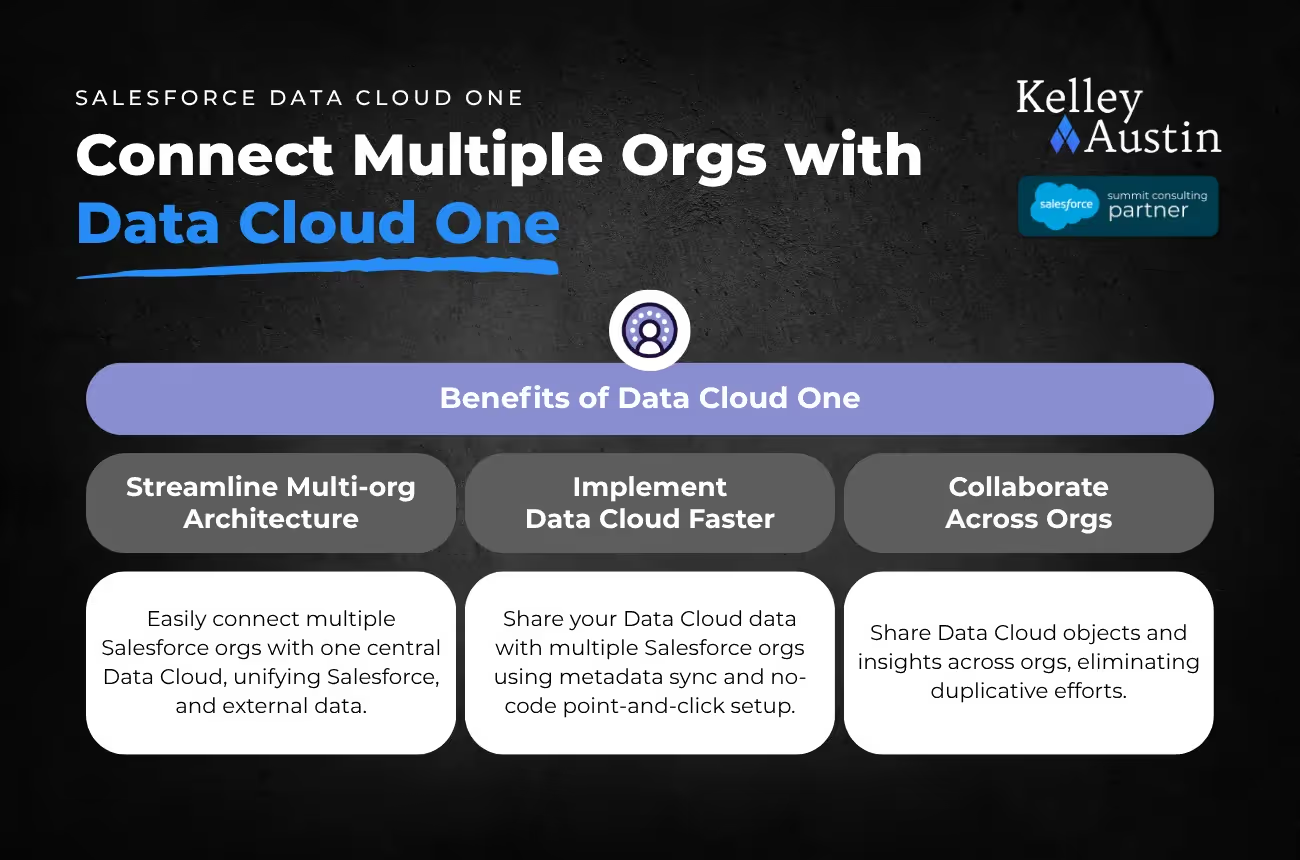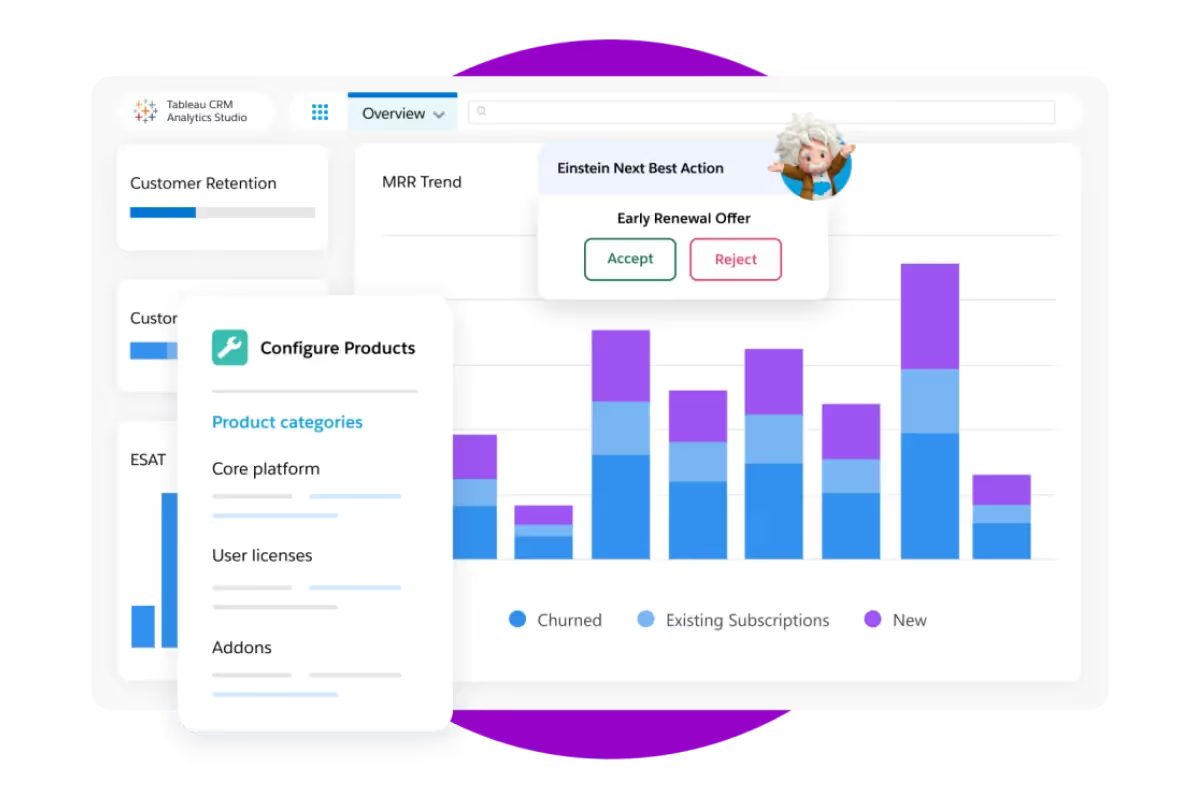Data Cloud One Powers Smarter Cross-Sell & Up-Sell for a Health Tech Company

The Challenges
Our client, a leading software company serving over 2,300 surgical care facilities across the U.S. and Canada, faced several challenges before working with Kelley Austin. Focused exclusively on perioperative IT, the company delivers solutions that drive operational, financial, and clinical outcomes.
Following a recent acquisition, our client faced a familiar challenge: siloed systems across two separate Salesforce orgs — one for Sales and one for Service. To make matters more complex, a previous Data Cloud implementation had only been partially completed — ingesting data but lacking unification, harmonization, and activation.
After acquiring the new company, our client faced the critical task of integrating the two businesses and unlocking the value of their shared customer base. However, several challenges stood in the way:
Siloed Salesforce Orgs Blocked Collaboration: Our client and their recent acquisition operated out of two completely separate Salesforce orgs — preventing teams from accessing or acting on each other’s data.
Missed Opportunities for Cross-Sell & Up-Sell: Both companies shared many of the same customers and prospects, but without a unified view of account activity, sales teams lacked the visibility needed to identify and pursue cross-selling or up-selling opportunities.
Incomplete Reporting on Combined Business Performance: With data scattered across two systems, leadership struggled to generate comprehensive reports that reflected the full scope of the business, impacting strategic planning and performance evaluation.
Manual Workarounds Slowed Teams Down: Without automated data synchronization, teams were forced to manually switch between systems or rely on incomplete information, increasing inefficiencies and the risk of errors.
The Solution

The company partnered with Kelley Austin to implement Data Cloud One, Salesforce’s next-generation integration architecture designed for multi-org environments. The solution bridged the two Salesforce orgs using a single shared instance of Data Cloud — enabling real-time, bi-directional data sharing and activation.
Key elements of the Data Cloud One solution built by our team include:
Provisioning, Configuration, & Ingestion: Configured data streams from both Salesforce orgs using native connectors to ingest key records — Accounts, Opportunities, Leads, Contacts, and Cases — into Data Cloud.
Data Harmonization, Unification, & Identity Resolution: Resolved duplicates and incomplete records using Identity Reconciliation Rule Sets for both individuals and accounts. Mapped all streams to standard DMO objects to create a single source of truth.
Data Activation via Companion Flows: Created Data Cloud-triggered flows in both orgs to act on changes. For example, when an Opportunity is created or updated in the companion org, a corresponding Opportunity is automatically created or updated in our client’s Salesforce org.
Cross-Org Visibility via Unified Related Lists: Sales reps in our client’s org can now view unified related lists from the acquired company’s org (Opportunities, Leads, Contacts, Accounts, and Cases) directly from the Account record — eliminating swivel chairing.
Simplified Architecture for Ongoing Innovation: Unlike older approaches that required complex processes or custom coding to share data across orgs, Data Cloud One offers a simplified and scalable foundation for future use cases, including Agentforce AI agents that can act across orgs using harmonized data.
Customer Impact
With Kelley Austin’s help, our client integrated their newly acquired company into its Salesforce ecosystem in a matter of weeks — a process that typically takes months or even years. The unified view delivered by Data Cloud One has already created tangible value across the business, including:
Faster Time to Value: Enabled real-time visibility and collaboration across orgs just weeks after kickoff — accelerating post-acquisition integration.
Smarter Selling & Service: Sales and service teams now operate from a shared data foundation, unlocking new opportunities for cross-sell and up-sell, while improving case handling and customer satisfaction.
Better Insights, Better Decisions: Enhanced reporting and analytics across both orgs provide leadership with a clearer, more complete view of the business.
Future-Ready Data Architecture: With a scalable multi-org integration model in place, our client is well-positioned to implement Agentforce use cases and predictive analytics tools.
The successful implementation of Data Cloud One marked a pivotal step forward for our client, transforming how the company connects, shares, and activates data across its growing ecosystem.
By eliminating silos, streamlining integration, and enabling real-time visibility between our client and their recent acquisition, Kelley Austin helped lay the foundation for scalable growth, smarter decision-making, and more personalized customer engagement.
With a unified data architecture in place, the company is now well-positioned to not only maximize the value of its acquisition but also to innovate faster — leveraging AI, automation, and insights that will continue to drive impact across the business.

